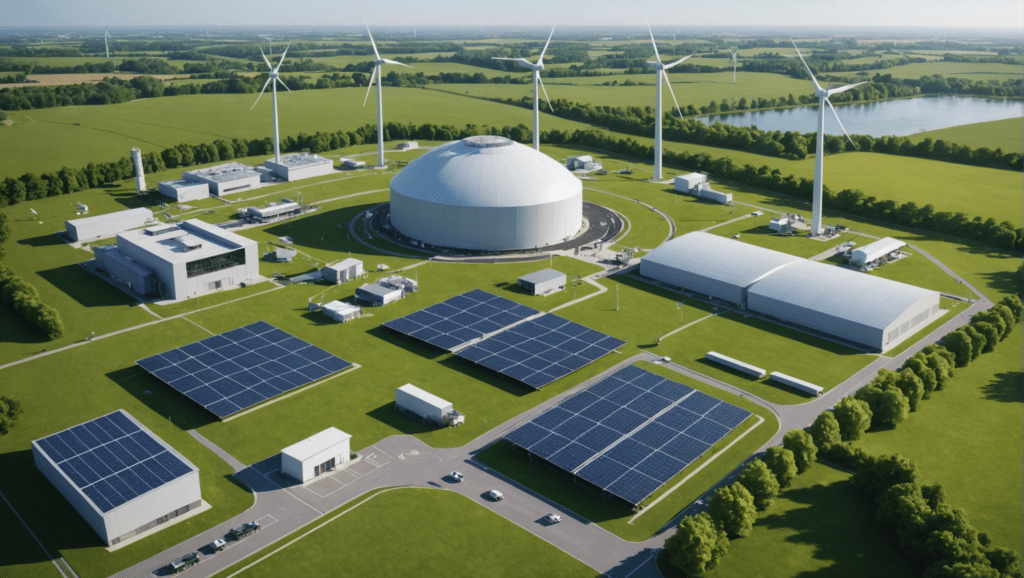Green hydrogen proves to be an innovative answer to current energy challenges. As a decarbonized and versatile energy source, it could play a decisive role in the energy transition towards a more sustainable future. By combining technological advances, such as water electrolysis powered by renewable energies, this clean hydrogen emerges as a key vector for developing a circular economy.
The opportunities presented by green hydrogen are numerous: from fueling transportation to stabilizing energy networks, including energy storage. Projects are multiplying and testify to a promising dynamic for reaching the climate goals set by many countries, including France. However, this sector does not develop without encountering major challenges. The production costs, the need to create suitable infrastructure, and the growing demand for renewable energy are crucial steps to overcome.
It is therefore essential to explore the issues related to green hydrogen, identifying both the undeniable advantages and the potential obstacles that hinder its full integration into our society.

Green hydrogen, often regarded as a future energy vector, is emerging as an essential solution to contemporary climate challenges. Its ability to store and transport renewable energy offers fascinating prospects for the energy transition. However, the challenges to be addressed for integrating this technology into the global energy mix are numerous and require sustained attention to maximize its benefits.
Opportunities Offered by Green Hydrogen
Produced by electrolysis, green hydrogen extracts hydrogen molecules from water using electric current from renewable sources such as solar energy or wind energy. This decarbonized process promises clean energy, with no CO2 emissions during use. By 2050, hydrogen could represent up to 20% of global greenhouse gas reduction targets.
A number of ambitious national projects are beginning to emerge. For example, a study by the CCI highlights more than 500 large-scale initiatives recently launched. These projects span various fields, including industry, transportation, and even housing. Additionally, major financial groups, such as Warren Buffett, are investing heavily in hydrogen-related technologies, indicating real confidence in this future sector (source).
In the field of transportation, spectacular innovations are blossoming. Notably, hydrogen-powered trucks require four times more renewable energy than their battery counterparts, demonstrating increased research into the synergy between hydrogen and other energy sources (source). Advances in electrolysis, which now allow for more economical hydrogen production, represent a decisive turning point that could disrupt traditional energy paradigms.
Challenges to Overcome for the Integration of Green Hydrogen
Despite its many promises, green hydrogen faces significant technological and economic challenges. One of the first obstacles concerns production costs. Currently, the budget required to produce green hydrogen remains, although decreasing, still very high compared to other energy sources. The need for a well-integrated renewable energy grid is also crucial (source).
Moreover, storage challenges remain. Hydrogen, while being emissible, has physical characteristics that make its storage and transport complex. Studies indicate that innovative storage solutions, such as lake infrastructure, could become strategic responses to this issue (source).

Finally, one of the largest questions concerns the development of a multi-energy network that allows for the smooth integration of various sources (wind, solar, and hydrogen) into the energy mix. In this sense, synergies must be established between electrical networks, thereby optimizing the use of green hydrogen as backup and storage energy. ADEME particularly emphasizes the importance of a collaborative approach to tackle these challenges, reinforcing the idea that the energy transition cannot succeed without a strong collective effort (source).
Future Perspectives for Green Hydrogen
For widespread adoption of green hydrogen, several improvement avenues can be considered. First, research and development must continue to advance to refine electrolysis technologies and reduce production costs. Additionally, state subsidy systems and financial aids must be optimized to support innovative projects in this sector, thus facilitating the emergence of sustainable energy solutions.
Furthermore, it would be wise to increase collaboration among various market players – industry, researchers, governments, and investors. Creating innovation hubs dedicated to green hydrogen could encourage the exchange of ideas and accelerate the rise of new initiatives. It is imperative that communication strategies are put in place to raise public awareness of the advantages of green hydrogen, thus engaging in a virtuous dynamic around clean energy.
Ultimately, while green hydrogen stands out as a potential leader of the energy transition, the challenges to address to make it an accessible reality should not be underestimated. The opportunities it offers, combined with thoughtful strategic choices, can truly shape our energy future in a sustainable and responsible manner.
Hydrogène vert : les objectifs européens pour 2030 jugés « irréalistes » par la Cour des comptes européenne https://t.co/ltxXCkiyqF #AFP
— Connaissance des Énergies (@info_energies) July 18, 2024
FAQ
What is green hydrogen?
Green hydrogen is hydrogen produced by electrolysis of water using electricity from renewable energy sources, such as wind, solar, or hydropower. Unlike grey hydrogen (produced from fossil fuels), it does not emit CO₂ during its production.
Why is green hydrogen crucial for the energy transition?
Green hydrogen is a clean alternative to fossil fuels. It offers potential to decarbonize hard-to-electrify sectors such as heavy industry (steel, chemicals) and long-distance transportation (planes, ships, trucks). As an energy vector, it can also store electricity produced by renewable energies in a more flexible manner.
What opportunities are offered by green hydrogen?
- Reduction of CO₂ emissions: Green hydrogen allows reduction of greenhouse gas emissions in key sectors, thus contributing to achieving climate goals.
- Energy storage: It offers long-term storage solutions for renewable energy, bridging gaps between energy supply and demand.
- Industrial development: Green hydrogen can stimulate the creation of new industries and infrastructures, fostering employment and technological innovation.
- Energy independence: It reduces dependence on imported fossil fuels, enhancing national energy security.
What are the main challenges for the development of green hydrogen?
- High production costs: Currently, producing green hydrogen is more expensive than grey hydrogen. This is due to the high cost of electrolyzers and the need for a large quantity of renewable energy.
- Infrastructure: The transportation, storage, and distribution of hydrogen require specific infrastructures that are still underdeveloped.
- Energy efficiency: The production of hydrogen through electrolysis is energy-intensive, and a portion of the energy is lost during the process, making the efficiency lower compared to other solutions.
- Regulatory challenges: Policies and regulatory frameworks around green hydrogen are still evolving. Harmonization of standards at the international level is necessary to foster its large-scale adoption.
What are the current applications of green hydrogen?
Green hydrogen is used in several sectors:
- Transport: Fuelling hydrogen vehicles (cars, buses, trucks), offering an alternative solution to electric batteries for long trips.
- Industry: Decarbonizing the production of steel, ammonia, chemicals, and other heavy industrial processes.
- Electricity: Used for electricity production in hydrogen-powered plants, allowing the storage and return of renewable energy.
How to reduce the costs of green hydrogen?
Reducing costs relies on several factors:
- Technological innovation: Improving the efficiency of electrolyzers and reducing their manufacturing costs.
- Economies of scale: By increasing the production and use of green hydrogen, production costs should decrease over time.
- Public and private investments: Subsidies and financial incentives can help accelerate the transition to green hydrogen.
Which countries or regions are ahead in developing green hydrogen?
Some countries and regions have taken major initiatives to promote green hydrogen:
- Europe: The European Union has an ambitious plan to develop green hydrogen with significant investments and pilot projects underway.
- Japan and South Korea: These countries are betting on hydrogen for their energy transition, particularly in transportation.
- United States: With investments in clean technologies, some states like California are at the forefront of green hydrogen development.
What are the long-term prospects for green hydrogen?
In the long term, green hydrogen could play a central role in decarbonizing the global economy, complementing renewable energies. It could help achieve carbon neutrality targets by 2050 in many countries while transforming key industries and fostering a sustainable and decentralized energy model.
How can companies engage in the development of green hydrogen?
Companies can:
- Invest in research and development (R&D) to improve production and use technologies for green hydrogen.
- Collaborate with governments and other sector stakeholders to develop distribution infrastructures and safety standards.
- Adopt green hydrogen in their supply chains and industrial processes to reduce their carbon footprint.
What are the environmental benefits of green hydrogen?
Green hydrogen offers significant advantages:
- Zero CO₂ emissions during production.
- Reduction of air pollution by replacing fossil fuels in transportation and industry.
- Encourage a circular economy by integrating into renewable energy systems, where excess renewable energy can be stored as hydrogen.
How can citizens support the development of green hydrogen?
Citizens can contribute to the transition towards green hydrogen in several ways:
- Support public policies: Encourage governments to invest in infrastructure and research for developing green hydrogen through petitions or votes in favor of green policies.
- Raise awareness about green hydrogen: Inform their surroundings about the environmental benefits of green hydrogen and promote its adoption in local transportation or industries.
- Make responsible consumption choices: Support businesses that adopt sustainable practices, including the use of technologies based on green hydrogen.
- Invest in renewable energy: As a consumer, choose renewable energy providers or invest in green projects, thus facilitating the adoption of solutions like green hydrogen.
Articles similaires
Thank you!
We will contact you soon.














